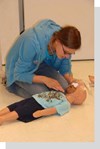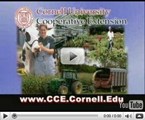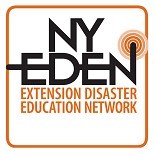Posted 2/6/2013
by Shannon Dygert

American Red Cross Babysitting Training Available for Local Youth
Cornell Cooperative Extension in Fulton and Montgomery Counties will be hosting an American Red Cross Babysitting program for youth ages 11-15 years old on Wednesday, April 3rd from 8:30 a.m. until 4:00 p.m. The class will be held at the Shirley J. Luck Senior Citizen Center, 109 East Main Street in Johnstown, New York. The American Red Cross Babysitter’s Training program will teach youth critical skills including how to supervise children and infants; basic child-care skills such as diapering, feeding and dressing; selecting safe, age-appropriate games and toys; identifying safety hazards and preventing injuries, caring for common injuries, and performing rescue breathing.
Youth will increase their skills and confidence in being competent babysitters by participating in this hands-on, educational training. The babysitting class is limited to the first 20 youth who register and pay the $60.00 class fee. The registration deadline is March 27th.
Individuals interested in registering for this program must contact Cornell Cooperative Extension in Fulton and Montgomery Counties at 673-5525 ext. 122 or email smd69@cornell.edu. The registration form is available below.
Posted 2/5/2013

4-H youth development to benefit from
“Stories from the Mohawk Valley” donation in February
Bob Cudmore’s February “seed money” donation is a $100 gift to the 4-H youth development program in Fulton and Montgomery Counties.
The donation comes from sales of Cudmore’s history book, “Stories from the Mohawk Valley.” In all, $2,200 has gone to area charities from sales of the book since its publication in 2011.
The 4-H youth program is being publicized on Cudmore’s morning radio show on Amsterdam’s Lite 104.7 FM / 1570 AM WVTL, plus audio streaming on www.wvtlfm.com
Posted 2/2/2013
by www.extension.org

This winter’s flu outbreak has been widespread, and children are particularly vulnerable to flu, colds and other illnesses this time of the year. Parents can help their youngsters fight off infections by providing them with a healthful diet.
“You can’t prevent getting sick by eating certain foods, but you can boost your immune system and its response to illnesses,” said Denise Holston-West, LSU AgCenter nutritionist.
Posted 2/1/2013

Choosing, Introducing, and Caring for Pets in Child Care
Having a pet to talk to and touch can be a great benefit to children in child care, especially shy youngsters. Children can learn responsibility by caring for a pet and may enjoy watching animals play and eat. Having a pet in your child care program takes thought and planning. Before you go out and buy a snake or a rabbit, be ready to ensure children are safe and healthy around the pet and the pet is treated gently and appropriately.
You also need to consider how children will react to pets in child care. Some children may be eager to interact with a pet, but others may be reluctant. Some children are scared of certain animals, such as dogs or snakes. The temperament of the animal also matters. Some animals are gentle and patient around children; others are frightened by noise or do not like to be touched. Before actually buying a class pet, consider having someone with a reliable pet come to visit with it. Prepare the children for the visit and see how they react to the pet. This may help you decide whether a full-time class pet is a good idea.
Remember that having a pet is a long-term commitment that does not end when the school year is over. If you are thinking of buying a pet for your child care program, think about who will take care of the pet on weekends, holidays and summer vacations. How will you ensure that the pet is healthy? Will the child care program pay for supplies and medical bills, or will you have to assume those responsibilities?
Posted 2/1/2013

National 4-H Survey looking for input
As you know, the goal of 4-H is to equip young people with the life skills they will need to be successful in their community and the world. Using research-informed programs, focused on positive youth development, 4-H provides youth with the hands-on real world experience they need to become leaders.
In collaboration with and support from members of the 4-H community, we (a group of students from Seattle Pacific University), led by Lynette Bikos, Ph.D. (a Missouri 4-H alumnus and a long-time 4-H volunteer) have set out to explore the factors that contribute to the use of research-based information throughout the 4-H organization.
So that we can gather a wide range of perspectives across this national organization, we need to have 600 people complete our survey. Please help us by participating.
Follow this link to the survey and for more information: https://www.surveymonkey.com/s/YYQCCLG
Posted 1/27/2013

Got Trees?
Get More from Your Woodlot
Free programs at the NY FARM SHOW February 21-23, 2013 State Fairgrounds, Syracuse, New York
Fifteen free programs to help owners realize greater benefits from their woodlands are scheduled for the 2013 Farm Show in Syracuse, February 21-23, 2013.
Learn from experts. Come with your questions. Learn more, earn more.
Landowners have a wide range of interests in their woods: peace and quiet, wildlife, wood products, recreation, future timber, and a family legacy, to name a few. Whatever your objectives, a greater understanding can help achieve a greater value from your woods.
Each year at the NY Farm Show, free forestry programs are presented by NYFOA with Cornell Cooperative Extension, the State Department of Environmental Conservation and the SUNY College of Environmental Science and Forestry, with support from others including the New York Farm Bureau, Audubon New York, and the Natural Resource Conservation Service of the USDA.
Programs are held in the Somerset Room of the Art and Home Center at the NY State Fairgrounds in Syracuse. Programs start on the hour and allow time for questions. Reservations are not needed.
Posted 1/27/2013

Make it an Energy-Efficient Super Bowl This Year
Save Energy While Enjoying the Big Game on an Energy-Efficient Flat-Screen TV
The week before Super Bowl is an opportune time to buy a flat-screen TV, according to CNN, because sales average 10 percent or more off the listed price, as manufacturers and retailers try to move excess inventory by enticing customers to watch the big game on a new screen. The New York State Energy Research and Development Authority (NYSERDA) recommends looking for ENERGY STAR® qualified TVs, as the U.S. Environmental Protection Agency (EPA)<http://www.energystar.gov/index.cfm?fuseaction=find_a_product.showProductGroup&pgw_code=TV> found that most consumers say energy efficiency will be a factor in choosing their next television.
Given that Nielsen<http://blog.nielsen.com/nielsenwire/consumer/the-cross-platform-report-a-new-connected-community/> reports Americans watch about 34 hours of television a week, it's important to consider that some ENERGY STAR models save more energy than others. The EPA currently requires larger TV sets to meet more stringent efficiency levels to earn the ENERGY STAR label. A 60-inch ENERGY STAR TV for instance will use nearly 40 percent less energy than a non-ENERGY STAR model. There are also a number of flat-screen technologies, such as LCD (Liquid Crystal Display) and plasma. These tips from NYSERDA will help you find the right TV for enjoying the big game and saving on energy costs:
Pick your picture quality.
Posted 1/22/2013
The ACT Youth Network, sponsored by the ACT for Youth Center of Excellence, has received the New York State Department of Health Commissioner’s Award for their extraordinary efforts in raising HIV/AIDS awareness. The award was bestowed in a ceremony commemorating World AIDS Day 2012 at the Empire State Plaza in Albany on December 5th . Providing consultation to the Department of Health, ACT for Youth, the Harlem Health Promotion Center, and Cornell University graduate students, among others, Youth Network members have brought youth voice to a wide range of projects promoting adolescent health. They have given early, essential feedback on the design and messaging of media campaigns, websites, focus groups, workshops, surveys, and more. Their input has made each project more accessible and relevant to youth. BCTR congratulates the ACT Youth Network, as well as coordinators Sara Henderson, Michele Luc, and Heather Wynkoop, on this high-profile recognition of their many achievements.
Posted 1/18/2013

Join the Worldwide GLOBE at Night 2013 Campaign
What would it be like without stars at night? What is it we lose? Starry night skies have given us poetry, art, music and the wonder to explore. A bright night sky (aka light pollution) affects energy consumption, health and wildlife too. Spend a few minutes to help scientists by measuring the brightness of your night sky. Join the GLOBE at Night citizen-science campaign (www.globeatnight.org). The first campaign starts January 3 and runs through January 12.
Posted 1/17/2013

Citizen scientists: The new research corps
More often than ever before, people from all walks of life - from retired senior citizens to young families – are helping scientists collect data that support research projects. This movement of “citizen science” has flourished over the past decade as technology has advanced, allowing volunteers to share information with researchers quickly and accurately.
In fact, there are several interesting examples of “citizen science” here at Cornell University, including a survey of backyard birds and a project called Yardmap that encourages homeowners to map their yards so that researchers can better understand the habitat available to birds.
This month, a group of researchers from the United Kingdom has published a review that details exactly how “citizen science” is working, including summaries of projects across the globe, interviews with scientists who use this data and , and a guide of the best practices for conducting these types of projects. The review found some interesting conclusions. Among them:
- The motivation for citizen scientists varies greatly. Successful projects tend to take into account the interests and skill-sets of participants, and their expectations.
- Getting feedback from volunteers is an important component of a sucessful project and is acheived through a wide variety of mediums, including social media and face-to-face interactions.
- Technologies such as GPS and smart phones have made it easier for citizens to share accurate data, but relying on these devices excludes those who don’t have access to them.















